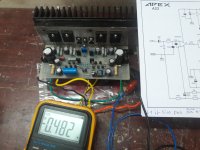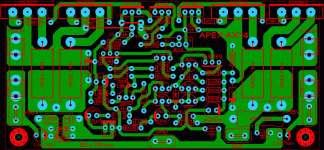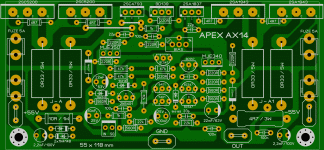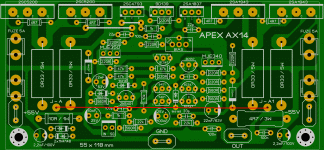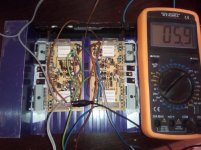Another FH9 freshly packed and ready to serve. The sound is surprisingly good! Many thanks to Sonal Kunal for the pcb layout. The VAS transistors are KSC2690 KSA1220 because it's easier to mount fully isolated TO126. Bias is only 30mA (yes I know that it should be 100-150mA).
Hi Ivan,
very nicely built. Congratulations!
regards
Prasi
AX-14 progress..... using for car audio
An externally hosted image should be here but it was not working when we last tested it.
An externally hosted image should be here but it was not working when we last tested it.
Another very nice driver is TTC/TTA004B. They are brand new development from Toshiba.
Sajti
Concerning Toshiba's I was unable to find if the TO126N means fully isolated case. Does the "N" suffix stands for fully isolated?
Concerning Toshiba's I was unable to find if the TO126N means fully isolated case. Does the "N" suffix stands for fully isolated?
It was described as epoxy encapsulated, but no guarantee for the fully isolation. However my experince, that 55V is no problem without further isolation.
Sajti
A23 !!
Hi Mr.Miles,
Just finished A23, Testing with power supply of +/- 45v ,Had bias problem and sorted out by increasing 220 ohms preset to 1k and 680 ohms to 820 ohms,,
Now able to set bias properly,,
Now I have DC offset about -0.482 V.. 😕
can you please help here....
Regards
Arasuk
Hi Mr.Miles,
Just finished A23, Testing with power supply of +/- 45v ,Had bias problem and sorted out by increasing 220 ohms preset to 1k and 680 ohms to 820 ohms,,
Now able to set bias properly,,
Now I have DC offset about -0.482 V.. 😕
can you please help here....
Regards
Arasuk
Attachments
Is the input gnd connected to power supply star gnd?Hi Mr.Miles,
Just finished A23, Testing with power supply of +/- 45v ,Had bias problem and sorted out by increasing 220 ohms preset to 1k and 680 ohms to 820 ohms,,
Now able to set bias properl
Now I have DC offset about -0.482 V.
can you please help here....
Regards
Arasuk
A23 !!
Thanks Thimios ,,Input Gnd was not connected to power Gnd 😀
now the offset is 1mv,,
Regards
Arasuk
Thanks Thimios ,,Input Gnd was not connected to power Gnd 😀
now the offset is 1mv,,
Regards
Arasuk
I love the sound:
Please repost without the links to the other sites.
Sorry now i see the button for attachments. 🙂
Attachments
Last edited:
Symmetrical CFA amplifiers do sound excellent but making them to perform consistently and without problems is not trivial task. There will be issues with stability, low PSRR, hum, etc. Solving these issues will require more complexity in the PSU or debuging using equipment that is not available to average builder, especially if novice or inexperienced.
Since many of the subjective advantages, if not most, are due to push pull VAS, one is tempted to combine diff input with push pull VAS, like Sansui engineers did in the late seventies (see basic Apex AX11 circuit). This is the circuit that is emulated by many industrial amps till this day (Harman Kardon, Pioneer, etc.) The question remains only how to configure input stage, to use single diff input pair (like Sansui did in it’s more economically priced models) or to use double diff input pair, like Borbely and Bongiorno, making whole amplifier fully symmetrical from input to output. It seems to me that single diff input pair has even more apealing subjective performance, probably due to less noise in the input stage where noise performance counts the most.
As far as the HEX fets are concerned, Bob Cordell in his excellent book, explicitly says that low power (50W/8R) single output pair HEX fet amp can be built without Vbe multiplier in spite of positive tempco. Having in mind low price of the HEX fets, single diff input pair VFA using symmetrical push pull VAS, appears to be the best overall compromise for simple (low transistor count) audio power amp. I was very impressed with the subjective performance of the Apex FH9 XRK mod amplifier which combines HEX fets with the basic Sansui circuit.
Keep in mind that push pull VAS is mandatory, it’s what makes audio circuits subjectively satisfying. There is an excellent highly sophisticated schematic of Sansui type amp by member DVV but I do not know if he will ever publish it here (with the component values). That amp is named Economy.
Since many of the subjective advantages, if not most, are due to push pull VAS, one is tempted to combine diff input with push pull VAS, like Sansui engineers did in the late seventies (see basic Apex AX11 circuit). This is the circuit that is emulated by many industrial amps till this day (Harman Kardon, Pioneer, etc.) The question remains only how to configure input stage, to use single diff input pair (like Sansui did in it’s more economically priced models) or to use double diff input pair, like Borbely and Bongiorno, making whole amplifier fully symmetrical from input to output. It seems to me that single diff input pair has even more apealing subjective performance, probably due to less noise in the input stage where noise performance counts the most.
As far as the HEX fets are concerned, Bob Cordell in his excellent book, explicitly says that low power (50W/8R) single output pair HEX fet amp can be built without Vbe multiplier in spite of positive tempco. Having in mind low price of the HEX fets, single diff input pair VFA using symmetrical push pull VAS, appears to be the best overall compromise for simple (low transistor count) audio power amp. I was very impressed with the subjective performance of the Apex FH9 XRK mod amplifier which combines HEX fets with the basic Sansui circuit.
Keep in mind that push pull VAS is mandatory, it’s what makes audio circuits subjectively satisfying. There is an excellent highly sophisticated schematic of Sansui type amp by member DVV but I do not know if he will ever publish it here (with the component values). That amp is named Economy.
Hy Mr. Mile i have a problem with my ax14, for one module the dc offset is big
21mA and for the another is ok only 7mA. What is the cause? Can help my? I want to use this for car audio. Thanks
21mA and for the another is ok only 7mA. What is the cause? Can help my? I want to use this for car audio. Thanks
Attachments
It's normal that you have different DC offset and those values are OK.
I tested the modules in the car and the sound produced by the offset is very bad with my canton RS 6 speakers. For home it's ok but for car bad!
- Home
- Amplifiers
- Solid State
- 100W Ultimate Fidelity Amplifier
